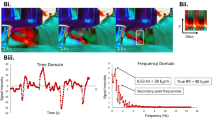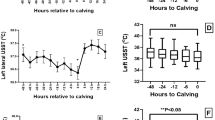Abstract
The aim of this study was to assess the variability of temperatures measured by a video-based infrared camera (IRC) in comparison to rectal and vaginal temperatures. The body surface temperatures of cows and calves were measured contactless at different body regions using videos from the IRC. Altogether, 22 cows and 9 calves were examined. The differences of the measured IRC temperatures among the body regions, i.e. eye (mean: 37.0 °C), back of the ear (35.6 °C), shoulder (34.9 °C) and vulva (37.2 °C), were significant (P < 0.01), except between eye and vulva (P = 0.99). The quartile ranges of the measured IRC temperatures at the 4 above mentioned regions were between 1.2 and 1.8 K. Of the investigated body regions the eye and the back of the ear proved to be suitable as practical regions for temperature monitoring. The temperatures of these 2 regions could be gained by the use of the maximum temperatures of the head and body area. Therefore, only the maximum temperatures of both areas were used for further analysis. The data analysis showed an increase for the maximum temperature measured by IRC at head and body area with an increase of rectal temperature in cows and calves. The use of infrared thermography videos has the advantage to analyze more than 1 picture per animal in a short period of time, and shows potential as a monitoring system for body temperatures in cattle.







Similar content being viewed by others
References
Berry RJ, Kennedy AD, Scott SL, Kyle BL, Schaefer AL (2003) Daily variation in the udder surface temperature of dairy cows measured by infrared thermography: potential for mastitis detection. Can J Anim Sci 83:687–693
Bland JM, Altman DG (1999) Measuring agreement in method comparison studies. Stat Methods Med Res 8:135–160
Burfeind O, von Keyserlingk MAG, Weary DM, Veira DM, Heuwieser W (2010) Short communication: repeatability of measures of rectal temperature in dairy cows. J Dairy Sci 93:624–627
Burfeind O, Suthar VS, Voigtsberger R, Bonk S, Heuwieser W (2011) Validity of prepartum changes in vaginal and rectal temperature to predict calving in dairy cows. J Dairy Sci 94:5053–5061
Chen PH, White CE (2006) Comparison of rectal, microchip transponder, and infrared thermometry techniques for obtaining body temperature in the laboratory rabbit (Oryctolagus cuniculus). J Am Assoc Lab Anim Sci 45:57–63
Chiang MF, Lin PW, Lin LF, Chiou HY, Chien CW, Chu SF, Chiu WT (2008) Mass screening of suspected febrile patients with remote-sensing infrared thermography: alarm temperature and optimal distance. J Formos Med Assoc 107:937–944
Georg H, Ude G, Schwalm A, Wenderdel B (2009) Investigation on temperature sensing injectable transponders for electronic animal identification an evaluation of suitable injection sites with bull calves. Landbauforschung Voelkenrode 59:287–293
Gloster J, Ebert K, Gubbins S, Bashiruddin J, Paton DJ (2011) Normal variation in thermal radiated temperature in cattle: implications for foot-and-mouth disease detection. BMC Vet Res 7. doi:10.1186/1746-6148-7-73
Johnson SR, Rao S, Hussey SB, Morley PS, Traub-Dargatz JL (2011) Thermographic eye temperature as an index to body temperature in ponies. J Equine Vet Sci 31:63–66
Kastberger G, Stachl R (2003) Infrared imaging technology and biological applications. Behav Res Meth Instrum Comput 35:429–439
Knížková I, Kunc P, Gürdil GAK, Pinar Y, Selvi KC (2007) Applications of infrared thermography in animal production. J Fac Agric OMU 22:329–336
Naylor JM, Streeter RM, Torgerson P (2012) Factors affecting rectal temperature measurement using commonly available digital thermometers. Res Vet Sci 92:121–123
Ng EYK, Kawb GJL, Chang WM (2004) Analysis of IR thermal imager for mass blind fever screening. Microvasc Res 68:104–109
Rainwater-Lovett K, Pacheco JM, Packer C, Rodriguez LL (2009) Detection of foot-and-mouth disease virus infected cattle using infrared thermography. Vet J 180:317–324
Rose-Dye TK, Burciaga-Robles LO, Krehbiel CR, Step DL, Fulton RW, Confer AW, Richards CJ (2011) Rumen temperature change monitored with remote rumen temperature boluses after challenges with bovine viral diarrhea virus and Mannheimia haemolytica. J Anim Sci 89:1193–1200
Schaefer AL, Cook NJ, Tessaro SV, Deregt D, Desroches G, Dubeski PL, Tong AKW, Godson DL (2004) Early detection and prediction of infection using infrared thermography. Can J Anim Sci 84:73–80
Schaefer AL, Cook NJ, Bench C, Chabot JB, Colyn J, Liu T, Okine EK, Stewart M, Webster JR (2012) The non-invasive and automated detection of bovine respiratory disease onset in receiver calves using infrared thermography. Res Vet Sci 93:928–935
Stewart M, Webster JR, Schaefer AL, Cook NJ, Scott SL (2005) Infrared thermography as a non-invasive tool to study animal welfare. Anim Welf 14:319–325
Thomas R, Campbell P (2006) Thermal imaging in surgery. In: Bronzino JD (ed) Medical devices and systems. The biomedical engineering handbook, 3rd edn, Electrical engineering handbook. CRC Press, Boca Raton, pp 33.1–33.18
Vickers LA, Burfeind O, von Keyserlingk MAG, Veira DM, Weary DM, Heuwieser W (2010) Technical note: comparison of rectal and vaginal temperatures in lactating dairy cows. J Dairy Sci 93:5246–5251
Wolfe WL, Zissis GJ (1985) The infrared handbook, revised edn. Office of Naval Research, Department of Navy, Washington, D.C. General Dynamics, Virginia
Ethical standars
The authors declare that all experiments comply with the current laws of Germany, where this study was performed.
Conflict of interest
The authors declare that they have no conflict of interest.
Author information
Authors and Affiliations
Corresponding author
Rights and permissions
About this article
Cite this article
Hoffmann, G., Schmidt, M., Ammon, C. et al. Monitoring the body temperature of cows and calves using video recordings from an infrared thermography camera. Vet Res Commun 37, 91–99 (2013). https://doi.org/10.1007/s11259-012-9549-3
Accepted:
Published:
Issue Date:
DOI: https://doi.org/10.1007/s11259-012-9549-3




